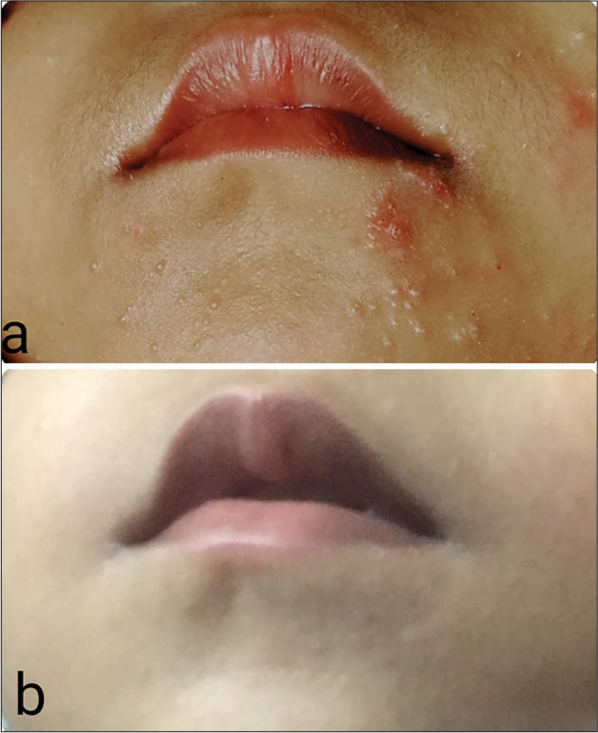Translate this page into:
The role of saturated hypertonic saline in treating molluscum contagiosum in pediatric patients

*Corresponding author: Muhammed Mukhtar, Department of Dermatology, Mukhtar Skin Centre, Katihar, Bihar, India. drmmukhtar20@gmail.com
-
Received: ,
Accepted: ,
How to cite this article: Mukhtar M. The role of saturated hypertonic saline in treating molluscum contagiosum in pediatric patients. CosmoDerma. 2024;4:135. doi: 10.25259/CSDM_162_2024
PROBLEM
The treatment choices for molluscum contagiosum (MC) on the face in children are limited because of its uncooperative nature. In many cases, MC resolves on its own within 6–12 months. There are several physical, keratolytic, pharmacological, immunomodulatory, and antiviral treatment options available. Lesions were eliminated 66.7–91.8% in 6–12 weeks with topical imiquimod, 100% in 3–6 weeks with cryotherapy and 10% potassium hydroxide (KOH), 90% with cantharidin, and 85% with intralesional purified protein derivative (PPD). Ingenol, cryotherapy, podophyllotoxin, and KOH are the most effective therapeutic options. To avoid local side effects, topical keratolytic therapies such as retinoic acid and salicylic acid are preferred.[1,2] However, retinoic acid requires a lengthy course of treatment and is effective in 65% of patients.[3] MC is also treated with manual extraction.[4] However, retinoic acid is the most desirable and cost-effective treatment for children in their early years. To overcome this issue, we used saturated hypertonic saline (SHS) as an adjuvant in conjunction with retinoic acid to cure MC rapidly and efficiently.
SOLUTION
We treated MC with retinoic acid (0.04%) as a keratolytic agent in combination with topical hypertonic saline (35.5%). Hypertonic saline (23.4%) was used as a sclerosing agent for varicose veins, with a concentration 26 times higher than physiologic sodium chloride (NaCl) (0.9%). We made SHS by dissolving 35.5 g of NaCl in 100 mm of water, getting a 26.2% solution (29 times the concentration of normal saline). It denatures proteins, destroys cell membranes, and kills them. On this basis, we utilized SHS topically in combination with retinoic acid to quickly damage intracytoplasmic MC virus in keratinocytes, causing the virus to be discharged into the surrounding area and thus damaged by host immunity and the sclerosing agent, with no substantial side effects across the site due to its topical application. The patients apply retinoic acid topically at bedtime and SHS to the lesions three times per day at home. The patient was examined fortnightly, and changes in the lesions were observed. The lesions healed in around 6–8 weeks [Figure 1a and b]. However, this treatment was tested on two male and one female children aged 1–3 years old, with lesions on the face in two and the belly and chest in one, lasting 2–6 months. This therapy is still in its early stages, having only been applied to three patients. To determine the effectiveness of this therapy, we should test it on a large number of patients.

- (a and b) The lesions of molluscum contagiosum resolved after 6–8 weeks.
Ethical approval
Institutional Review Board approval is not required.
Declaration of patient consent
The authors certify that they have obtained all appropriate patient consent.
Conflicts of interest
There are no conflicts of interest.
Use of artificial intelligence (AI)-assisted technology for manuscript preparation
The authors confirm that there was no use of artificial intelligence (AI)-assisted technology for assisting in the writing or editing of the manuscript and no images were manipulated using AI.
Financial support and sponsorship
Nil.
References
- Molluscum contagiosum: An update and review of new prospectives in etiology, diagnosis, and treatment. Clin Cosmet Investig Dermatol. 2019;12:373-81.
- [CrossRef] [PubMed] [Google Scholar]
- Comparative efficacy of molluscum contagiosum: A systemic review and network meta-analysis. J Dtsch Dermatol Ges. 2023;21:587-97.
- [CrossRef] [Google Scholar]
- The efficacy of 6 weeks course of 0.05% Topical retin-A in the treatment molluscum contagiosum: A cohort study. Indian J Public Health Res Dev. 2019;10:1012.
- [CrossRef] [Google Scholar]
- Surgical pearl: Disposable syringe as a molluscum body extractor. CosmoDerma. 2023;3:38.
- [CrossRef] [Google Scholar]





